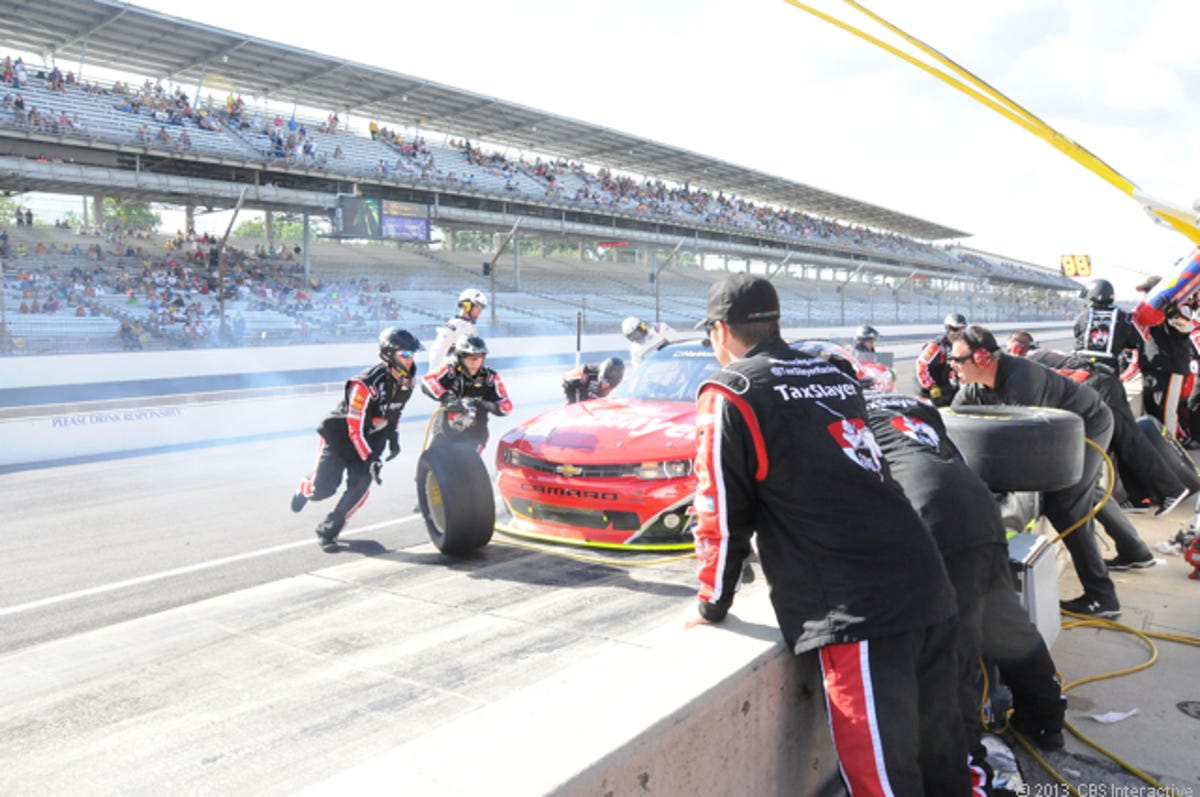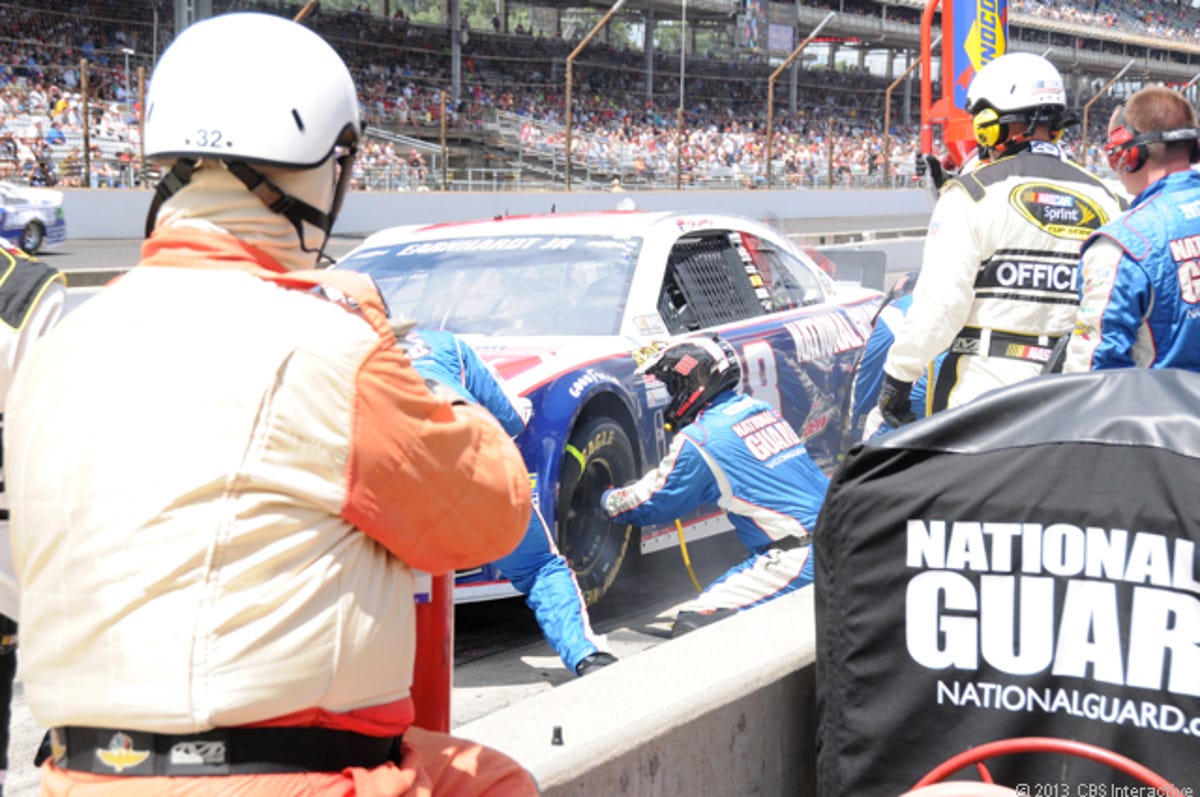Road to Indy: The life of a Goodyear racing tire (pictures)
Goodyear makes more than 100,000 racing tires a year for Nascar. CNET Road Trip 2013 reports on the entire lifecycle, from manufacturing in Akron, Ohio, to hitting nearly 200 miles an hour at the Brickyard 400.

Pit stop
AKRON, Ohio and INDIANAPOLIS -- When you buy a set of new Goodyear tires for your car, you have every reason to expect that they'll last you 80,000 miles. But when a Nascar team gets its hands on a set of Goodyear's racing tires, the expectation is a little lower: just 100 miles.
For years, Goodyear has had the exclusive contract to provide racing tires for Nascar. And that means that over the course of a year, Goodyear makes approximately 100,000 tires for Nascar teams, at a pricey $474 per.
As part of Road Trip 2013, CNET reporter Daniel Terdiman stopped in at Goodyear's racing tire manufacturing facility in Akron to see how they're made, and then saw the other end of their lifecycle (although not the exact same tires) at one of Nascar's biggest events, the Brickyard 400, at the Indianapolis Motorspeedway.
Goodyear's racing tires are made to exacting specifications and are tracked at every step of the way after being delivered to a race team. That's because everyone involved -- from the racing teams, to Nascar, to Goodyear -- wants to see how the tires perform, not least because simply looking at them and seeing how they're worn after a race can tell a lot about how the car that used them was driven.
Nascar teams are trained to change a full set of tires in about 15 seconds, as seen here. But sometimes, even that many seconds is the difference between winning and losing. In this year's Brickyard 400, eventual winner Ryan Newman held off favorite Jimmie Johnson by electing to replace just two tires during his last pit stop, saving precious seconds.
Pressing rubber in the die
In order to produce a racing tire's tread, Goodyear workers run what's known as green rubber through a machine called an extruder. There, the rubber is heated and blended to the point that it's soft enough to formed. At that point, it's run through a die, which pushes out a long, continuous strip of rubber.
Coming off the extruder
Heated rubber, forming a continuous strip, is pushed through the die. After making its way through the extruder, the rubber is laser-measured to make certain that its shape meets engineers' specifications. It's then sent down a conveyor belt to be cooled and cut to the desired length.
Building edges
Additional components of a tire, like its belts, are manufactured in a machine known as a calender. There, large rolls of nylon, aramid, and fiberglass are fed into the machine, where they have a rubber coating added to each side and between each individual cord. The goal is to completely encapsulate each cord in rubber.
This is the bead, a hoop-shaped tire component, two of which go in each tire. The bead is the rigid part of the tire that keep it held firmly to the wheel. The bead also gives the tire its round-shaped opening. The bead is made by encapsulating high-tensile steel wire in rubber and winding it around what's known as a mandrel into a hoop shape.
Tire construction
After making all the different tire components, they are moved to a tire building machine, where highly-trained builders assemble the tires by hand. Known here as "green tires," they are constructed in two separate sections -- the carcass, which provides the load-carrying capability of a racing tire; and the belt package, which is responsible for the shape and footprint of the tire at high speeds.
Making a tire
In order to make a carcass, the builder begins with an interliner made of rubber, which is designed to keep air sealed inside the tire when it's inflated. After that, the rubber-coated fabric piles, which were manufactured at the calender, are added to the inner liner. This gives the tire its shape.
Next, the beads and other components are added, stiffening the sidewall.
Inflating
Next, an airbag in the machine inflates, giving the tire a shape nearly identical to what its final dimensions will be. Doing this makes it possible to put the tire's many components in the proper position before the tire is cured.
A tire builder will also create the belt package at this point, adding two belts applied at diagonal angles, and folded over each other to increase strength. As well, a small fabric strip known as an overlay, is wound around the tire, helping to reinforce the tire's shape and structure at high speeds.
Lastly, a one-eighth of an inch-thick strip of tread is added. The tread is that thin because a racing tire is designed for heat resistance and grip rather than a long tread life.
Finally, the carcass and the belt packaged are put together, and an automatic roller presses them together. It is now a "green tire," and a barcode sticker is applied.
Adding RFID
Nascar tracks tires at every step of the way, from delivery to the teams to the race, and beyond. To do so, they track RFID tags that are applied as the final step in the green tire's assembly.
Curing
The green tires are then taken to a curing press, where a hot mold closes around the tire, and an airbag inflates insides, providing the tire's shape. This process vulcanizes the rubber through the application of specified and tightly-regulated amounts of heat and pressure.
Lastly, the curing press opens and the tires are taken out and moved to a conveyor that takes them to an inflation machine. There, it is inflated for 30 minutes in order to retain its shape and size during the cooling process.
Components of a race tire
A look at the wide variety of components that go into a Goodyear racing tire.
Wall of tires for teams
After the manufacturing process, the tires are eventually shipped to one of the many Nascar races held throughout the United States each year. Generally, there's about a 30-day lag between production and the race.
According to Nascar rules, each team participating in a Sprint Cup Series race -- which is Nascar's major leagues -- can use up to 10 or 11 sets or tires, depending on the race. The tires are not all the same, however. Right-side tires are about an eighth of an inch larger than left-side tires and usually have higher pressure, which helps cars in the turns on a racetrack stay stable
This wall of tires is outside the Goodyear garage at the Indianapolis Motorspeedway prior to the Brickyard 400. Typically, Goodyear brings about 4,500 tires to each Nascar race.
Fitting tires on wheels
Goodyear delivers all its tires to the racing teams mounted on wheels. The goal, as with much of what Nascar mandates when it comes to racing specifications, is to ensure that each team is on a level playing field, regardless of its financial resources.
Here, Goodyear crew members mount the tires on wheels using special machines.
Inner tube
On any racing track longer than a mile, Nascar requires that cars use tires featuring a tubeless inner tire designed to allow the driver to make it safely back to the pit in case of a flat.
White wheel for No. 2 car
While most Nascar teams use black wheels, the No. 2 car, driven by Brad Keselowski, sports white. Keselowski's tires for the 2013 Brickyard 400 are seen piled up outside Goodyear's garage at the Indianapolis Motorspeedway.
Two valves
On one of Keselowski's wheels, you can see the two valves that belong both to the main tire and to its tubeless inner tire.
Keselowski racing on white wheels
Keselowski races through his qualifying round on the white wheels on which his team has its Goodyear racing tires mounted.
No. 88
Nascar favorite Dale Ernhardt Jr.'s No. 88 car is seen being pushed back off the track after he completed his qualifying run the day before the Brickyard 400.
Left and right tires laid out
In the pit area, a racing team has laid out two sets of Goodyear racing tires, with the right and left tires designated by different color strips. Goodyear's right-side racing tires are slightly bigger and often are filled to a higher pressure than the left side tires. That's helps keeps the cars stable as they go left around every curve on the track.
Worn tire
Most Nascar teams replace their cars' tires every time they refuel, which is about every 100 miles. This is what a tire looks like after being pulled off a race car at a Nascar event. Note the rough surface, which used to be very smooth and unmarked.
Carting out worn tires
A team member carts a load of tires out of pit row after they were pulled off a car during the Brickyard 400.

Putting new tires on the 88 car
Earnhardt's crew races through a pit stop, replacing No. 88's tires. During the Brickyard 400, Earnhardt lost his position early in the race due to a loose wheel. But he eventually managed to make up most of his lost time and finished in sixth place after falling all the way to last place.
Measuring wear
A team member uses a special tool to measure the wear on a tire that has been pulled off a car during a pit stop. The teams -- and Nascar -- keep close track of data like this because it tells them a lot about how the drivers are performing, as well as how the tires do under the extreme conditions of a Nascar race.
Burning off tread
A pit crew member uses a flame to burn off worn tread in order to measure exactly how much wear the tire took while it was on the car.

